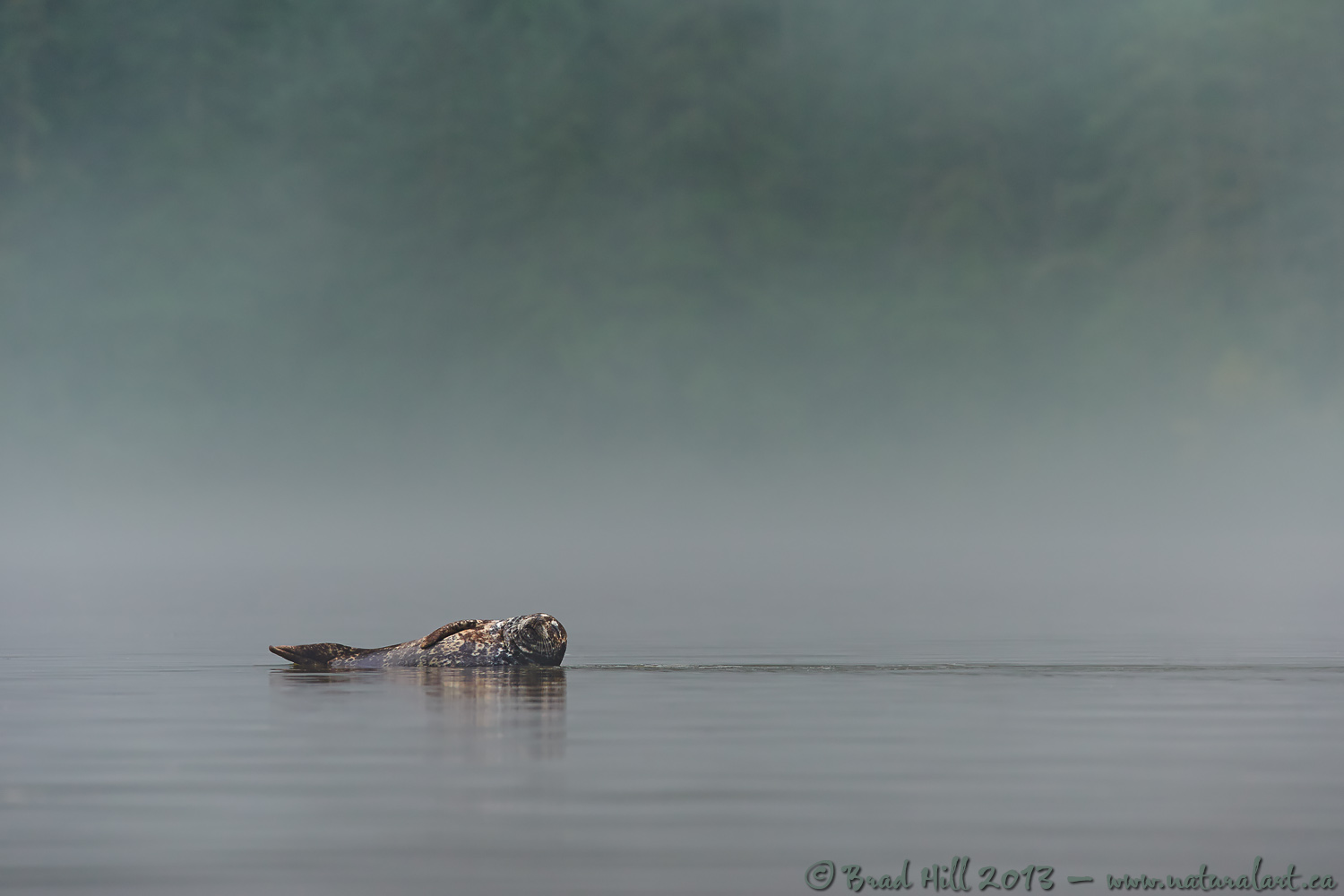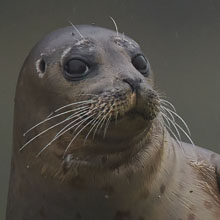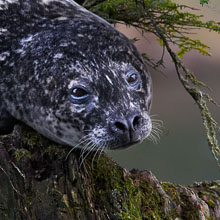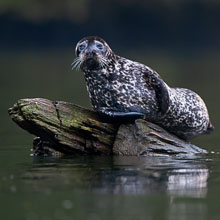Availability: Undetermined - Enquiries?
In the Field
Going Against the Flow. Great Bear Rainforest, BC, Canada. October 6, 2013.
I nabbed this shot of a Harbor Seal apparently sleeping while floating at the end of a narrow inlet in the Great Bear Rainforest. I shot this image just after the slack of high tide - and the water was now beginning to recede (rapidly!). The seal was actually perched on top of a barely submerged log, and was able to hold its position against the water flow with no effort. The ripples extending downstream from the seal (to the right of the seal as you look at the image) are tell-tale indicators of the flow of the tide (and definitely made me think "hey, how's he doing that?" - until I figured out he was atop a submerged log).
I loved the simplicity and peacefulness of this scene, thanks largely to the heavy mist in the background. For me the mist made the shot work, and how the scene looks now mirrors what I believe I saw in the field. But...it's a long way from how the raw image (or, the final product if you were shooting JPEG's) appeared straight out of the camera. Simply put, shooting in misty conditions with modern digital cameras often results in totally flat images that are pretty much washed out - from foreground to background. In the untouched raw file the seal was visible, but almost totally lacking in detail and colour (and contrast). And the background was close to detail-less (the distant forest could NOT be made out).
So...what kind of post-processing "tricks" were needed to bring this image back to life and to create the almost 3D look to a previously flat-looking capture? The good kind - the ones that bring the scene BACK to how it looked in the field (not AWAY from how it appeared). First, both the black point and the white point (which are intimately related to image contrast) had to be re-defined. This was accomplished by adjusting the "Levels" during raw processing. How much of an adjustment? A significant one - the white point was moved from 255 to 221, and the black point from zero to 24. There was no math behind these adjustments - just good ol' eyeballing on a calibrated monitor. The net result of this change was to bring the seal and foreground water - quite literally - out of the fog.
The next major step (again performed during raw processing) was to pull some detail out of the background (so that the forest became faintly visible). This was done by making a selective tone curve adjustment focused on the mid-tones. The key to making this adjustment was picking the correct point on the tone curve as the "deflection point" to "pivot" around (while going from a linear tone curve to a mildly "S-shaped" curve). How did I pick the point? By dragging the eye-dropper tool (in my raw converter) over the trees in the background and finding the tonal mid-point (around which I wanted to pivot the curve). Confused? Don't worry, it gets worse! ;-)
It was impossible to get the type of selective control in tonal transitions and contrast I wanted by performing these adjustments on a single raw file. So...the adjustments above were made on 4 different versions of the same raw file (which were then outputted as separate 16-bit TIFF files). I then merged and blended the four TIFF files in Photoshop CC through using a series of careful masking operations (and more than a few different masking "tricks"). Easy peasy? For some perhaps, but likely not for most. Hey...if it was too easy, everyone would be a wildlife photographer! And I'd have fewer folks wanting to go on my instructional photo tours! ;-)
For those wishing to more closely scrutinize this image, here's a 2400 pixel wide version of it:
• Going Against the Flow: Download 2400 pixel image (JPEG: 0.8 MB)
ADDITIONAL NOTES:
NOTE 1: This image - in all resolutions - is protected by copyright. I'm fine with personal uses of it (including use as desktop backgrounds or screensavers on your own computer), but unauthorized commercial use of the image is prohibited by law. Thanks in advance for respecting my copyright!
NOTE 2: Like all wildlife photographs on this website, this image was captured following the strict ethical guidelines described in The Wildlife FIRST! Principles of Photographer Conduct. I encourage all wildlife photographers to always put the welfare of their subjects above the value of their photographs.
NOTE 3: This image was captured during one of my "Into the Great Bear Rainforest" photo tours in the autumn of 2013. Each year I offer trips into two different parts of the Great Bear Rainforest as well as one to photograph aquatic mammals and oceanscapes near the northern tip of Vancouver Island. And, in selected years, I also offer photo tours to locations to capture other highly sought-after subjects, such as various owl species of the boreal forest and wildlife of Canada's Arctic. Details about these trips can be found on the Photo Tours page of this website.
Behind the Camera
Going Against the Flow. Great Bear Rainforest, BC, Canada. October 6, 2013.
Digital Capture; Compressed RAW (NEF) 14-bit format; ISO 450.
Nikon D4 paired with Nikkor 400mm f2.8G VR lens. Hand-held in floating Zodiac inflatable boat. VR on and in "Normal" mode.
1/400s @ f7.1; -0.67 stop compensation from matrix-metered exposure setting.
At the Computer
Going Against the Flow. Great Bear Rainforest, BC, Canada. October 6, 2013.
RAW Conversion to 16-bit TIFF, including first-pass/capture sharpening using Capture One Pro version 7. Four raw variants (different versions of a single raw capture) processed, with each differing in levels and curve tone adjustments.
Further digital corrections on resulting 16-bit TIFF files using Adobe's Photoshop CC and Light Craft's LightZone. Photoshop adjustments included compositing (blending) of the four raw variants, further selective contrast adjustment (via a selective curves adjustment layer) and sharpening for web output. Final tone tweaking performed using tonemapper/re-light tool in LightZone.
Conservation
Going Against the Flow. Great Bear Rainforest, BC, Canada. October 6, 2013.
Ten percent of the revenue generated by this image will be donated to The Raincoast Conservation Foundation.
Species Status in Canada*: Most Harbour Seal populations in Canada are not listed as Threatened or Endangered. The Lac des Loups Marins landlocked population of Quebec (Ungave Peninsula) currently listed as Endangered (most recent assessment update - November 2007).
The Harbour Seal (Phoca vitulina) is found on both the eastern and western coasts of North America. They tend not to make long migrations and in many areas they are present year-round. When foraging Harbour Seals normally dive to between 30 and 100 metres in depth and stay below the surface for 5 to 6 minutes. On occasion they have been known to dive to depths of over 450 metres and have stay submerged for almost 30 minutes. Harbour Seals have a diverse diet, including cephalopod, crustacceans and a variety of fish such as herring, eulachon, pollock, and salmon.
Historically bounty programs were used in both Canada and the USA to reduce populations of Harbour Seals. In more recent times seals have become protected over much of North America and some populations have rebounded strongly (it is estimated that over 150,000 seals now occupy the coast of British Columbia). There is a land-locked and freshwater sub-species of the Harbour Seal found on the Ungava Peninsula of northern Quebec. This population is now down to an estimated 100 individuals and is listed as Endangered by COSEWIC.
The The Raincoast Conservation Society (and Foundation) is an effective and efficient organization that has been fighting for protection of this unique habitat. If you are looking for a meaningful way to contribute to the conservation of this amazing ecosystem, Raincoast will provide maximal "bang" for your conservation dollars.
For more information on the status of Brown (Grizzly) Bears in Canada, go to: http://www.sararegistry.gc.ca and search under "Grizzly Bears"
*as determined by COSEWIC: The Committee on the Status of Endangered Wildlife in Canada.

























